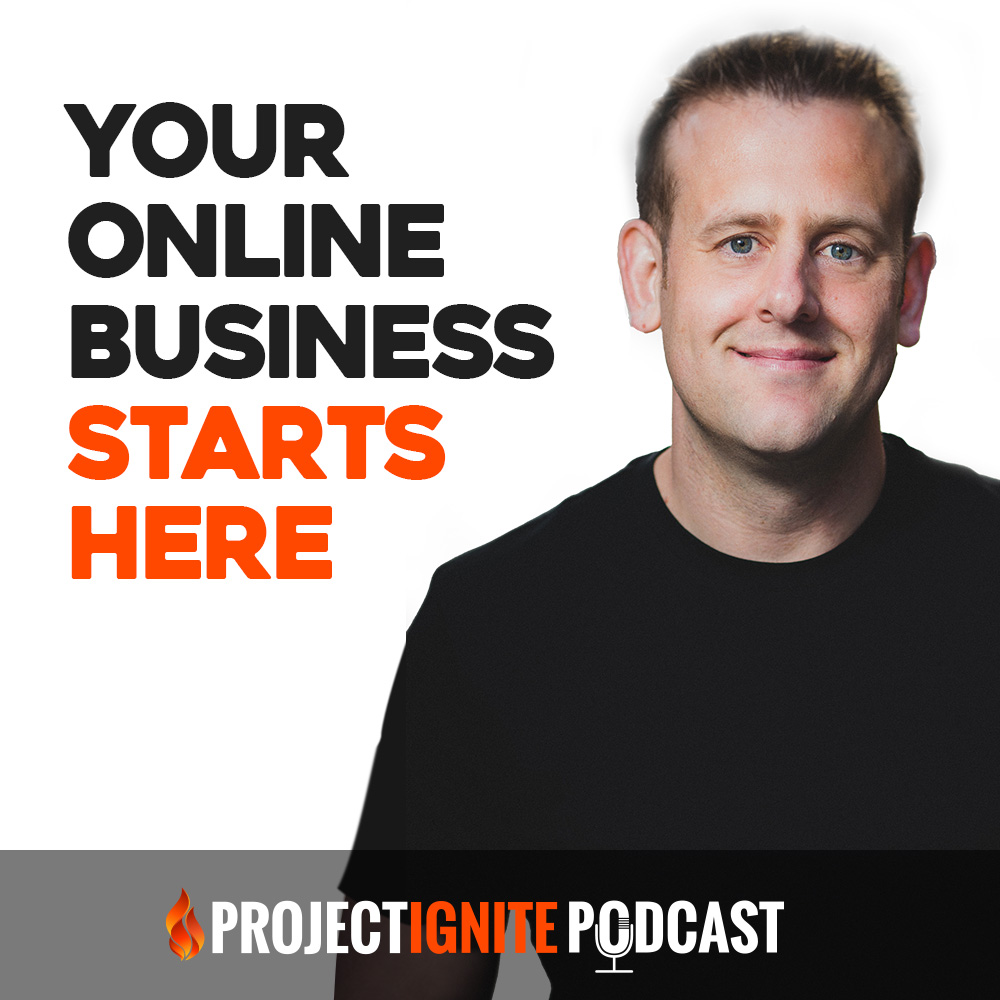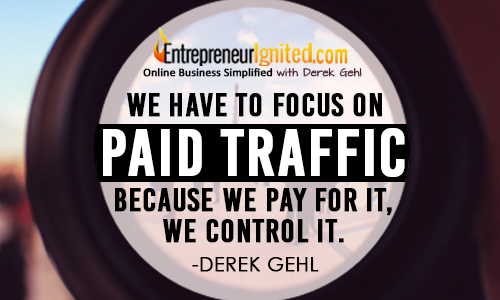Summary:
In this quick podcast, I get into the single biggest mistake I see people make when they consider online their traffic generation methods. It’s more complicated than you think, but it doesn’t have to be impossible!
Transcript: The Psychology Behind Successful Traffic Generation Methods
What I want to talk about today is the psychology behind online traffic generation methods,
While I was out on the road, connecting with so many people, I always look for patterns in the questions that people ask me. If ten different people ask me the same question, then I know that this idea is in a lot of people’s minds, so I want to address one specific topic around traffic generation. It won’t take long.
I just want to make sure that you have the right mindset behind online traffic generation. If you’re already generating hundreds of thousands of visitors month to month, if you’re already kicking ass and taking names, making money–you can probably skip this podcast.
If you’re either just getting started or aren’t generating the traffic you want or getting the results you want, I think this is one of the most prevalent mistakes that people make and I see them make it all the time when they’re getting started.
The topic I want to address is free traffic versus paid traffic. The reason why is this:
I see a lot of businesses coming online, putting tons of time into getting free traffic to their site.
The fact is, I love free traffic! If I can be getting lots of high quality, targeted, free traffic to visit my site, I’m going to say yes every time. If they’re not targeted, and they’re not buying, then it doesn’t matter.
But free traffic is great. I’m not gonna deny that good free traffic from Google can convert like crazy, but there’s a fundamental problem with generating free traffic like this. I want to use a real estate analogy here.
When you invest in real estate, and you buy real estate, when you buy it there’s something called capital growth. That’s when the real estate you buy increases in value over time. This could be for numerous reasons: the economy is going up, or demand is going up. You don’t do anything else to that real estate, it just goes up over time.
Free traffic is a little like capital growth when you’re investing in real estate.
When we buy real estate, and the capital growth goes up over time, we’re really happy with that. But ask yourself: do you have any control over capital growth in real estate? No. You don’t. If you get it, you love it; free traffic is that way.
If we get free traffic, we love it. But the fact of the matter is, we have relatively little control over free traffic. Now of course, you can do all of the things you need to do to optimize your website, and to rank well.
But when something is free, do you really have any control over it? The short answer is no. Again, I’m not trying to talk you out of free traffic, because I love it, but we have very little control over it.
The problem that I see is people that are just starting out spending a ton of time on generating this free traffic, and first of all, there’s no such thing as free. If you’re investing time into it that’s a cost associated with that traffic.
Free traffic itself, we have very little control over. I can go back to all of my businesses that have relied solely on organic traffic from search engines. I’ve seen so many business come and go as rankings change and traffic dries up.
Free traffic is fantastic but shouldn’t be your only source of traffic.
Here’s what the entrepreneurs I know do. Paid traffic is the key. When you’re paying for something, you have a say in the results. It’s more secure. Pay per click, Ad Words, anything like that.
Paid traffic, in my books, is your long term way to scale. If you’re relying totally on free, I would suggest that your businesses is kind of a house of cards, because that traffic can disappear.
When you’re paying for it, things can change and shift, but there’s a little more consistency. Things can definitely still change, but you definitely have more control when you’re buying traffic through different channels where you’re reaching your target market.
So here’s a question that you should not be asking yourself when you’re getting started. This is pertaining to paid traffic. The question I always get is how much should my budget be to generate paid traffic?
That’s the wrong question. You should never be buying clicks just for the sake of getting clicks.
If I spend one dollar, and I want to make two dollars–and I know that this is a generalization, but if I’m investing in traffic, I should be seeing a return on my investment.
If I can go out and buy a click for a dollar, and I can make two dollars on it, how many times should I spend that dollar?
As many times as is humanly possible, for as long as it’s returning a profit.
We’re shifting how we think about generating traffic. So let’s recap: we started talking about free traffic, which is great, but it’s not how we want to build our business. It isn’t reliable. If we’re not paying for something, we don’t have a lot of control over it.
For long term growth, we need to find sources of paid traffic where we can pay to get targeted buyers to our websites.
Then we got to, what should my budget be to go out and get that traffic? But remember, that is the wrong question to ask. We don’t want to spend money just on getting clicks, we want to make money.
So if I spend a dollar and get two back, we want to spend as many dollars as possible to buy that traffic profitably.
This is something that is your long term goal. This is what advanced marketers know. When you pay to acquire a visitor, you’re effectively buying sales. What smart marketers know is this: whoever can afford to spend the most on advertising in a specific niche, or can spend the most to buy a specific market click, is going to win in that market. This is because they can outspend their competitors.
If you’re competing to buy the same advertising and can only afford a dollar per click, but I can afford a dollar fifty per click, then I’m going to own that market. So the question becomes, how do I outbuy you?
This is where again more experienced marketers know that when you’re calculating how much you can spend to buy a sale, we don’t just look at our ROI on the initial transaction. Instead, we look at the lifetime value of a giving customers.
Let’s say we need to drive fifty visitors before we can make a sale, and we need to spend two dollars per click. So we’re spending a hundred dollars to get a sale.
Let’s say that our sale makes us $75. That means we’ve lost $25 acquiring that customer. Now we’re not even talking about buying clicks, we’re talking about the cost of making a sale.
Again, this is a mindset shift. When people start out, they look at it and think, this isn’t profitable, I can’t afford to keep doing this. But that’s what the mindset shift is: experienced marketers aren’t going to say, “I’m losing $25 on this sale.” They’re going to say, “what’s the lifetime value of this customer?”
Over the next thirty days, can I sell them another $25 of stuff? Then, can I sell them more stuff to make it profitable?
It’s a mindset shift for people that are just getting started. There’s too many people that look at it and think, “I need free traffic, and if I buy traffic, it needs to convert profitably right away.”
Of course, you need to be thinking about improving your conversion, but mostly you need to be thinking, what is my lifetime value of those customers?
It can be pretty difficult to figure out when you’re getting started, but understanding that psychology is a good first step.
Let’s just take a step back and recover what I’ve talked about there.
So, free traffic is great but unreliable. So we have to focus on paid traffic. Because we pay for it, we control it.
How much should our budget be? Well, that doesn’t matter. Our goal is to buy traffic profitably. If we spend one dollar, we want to make two back. Should we expect to make that money back right away? Maybe not. That’s why we need to have a good sequence and follow-up sequence so we can maximize on that customer, improving their lifetime value, so we can afford to spend more on acquiring customers.
In niche markets, the person that can spend the most to buy traffic, is the person that will own that market.
So hopefully we’re shifting that mindset of traffic generation for those that are a bit newer to this, and are kind of reframing how we’re approaching this.
To wrap things up, I want to share one more secret to traffic success. The secret is diversification. What I know to be 100% true, is every business that I’ve watched over 15 years that has relied on only one source of traffic, is that eventually things change.
Algorithms change, new competitors come into markets, things shift.
If you do not diversify your sources of traffic, eventually that source will change and if you only have one source of traffic, overnight your source of sales can dry up.
There are no businesses that I know of that are relying on the same source of traffic as they were five or ten years ago. It changes.
Out of everything you’ve taken away here, the last message I want to leave you with is diversification. You need to diversify your sources of traffic.
When you’re starting out, are you going to have multiple sources of traffic? No. Probably not. You’re going to maximize one, and then move to the next one as quickly as possible.
Am I saying don’t optimize free traffic? No! Rank! Get that free, quality traffic as best you can. All I’m saying is that every business I’ve seen scale has never relied solely on free traffic. They’ve always unlocked paid traffic.
There you go. Hopefully I’ve got you asking the right questions, and thinking in the right directions when it comes to generating traffic.
In future episodes, I’m going to dive into more specific generation strategies, but before you can dive into the specifics, you have to get the basics.
Thanks for listening to this podcast! As usual, you can find the transcripts and shownotes at ProjectIgnite.com/podcast. If you haven’t subscribed on iTunes, by all means, subscribe and leave us a review! If you’re an android user, you can also find us on Stitcher.com and soundcloud.
Thanks a lot everyone, and we’ll see you in the next episode.
















